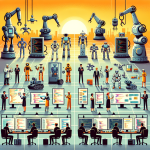Introduction
Mechanical engineering, a cornerstone of technological advancement and innovation, has historically been a male-dominated field. However, the past few decades have witnessed a significant shift as women increasingly break barriers to establish their presence in this discipline. From pioneering innovations to leadership roles, women in mechanical engineering are redefining the landscape and inspiring future generations. This article explores their journey, challenges faced, and the impact they continue to have on the industry.
Historical Context
The involvement of women in engineering can be traced back to notable figures like Ada Lovelace and Emily Roebling, who made significant contributions to fields that intersect with mechanical engineering. However, it wasn’t until the late 20th century that women began to enter engineering disciplines in substantial numbers, driven by civil rights movements and changing societal norms. Yet, even as they entered the profession, persistent stereotypes and systemic barriers remained.
Challenges Faced by Women in Mechanical Engineering
-
Cultural and Societal Barriers: Traditional gender roles have often dissuaded women from pursuing careers in STEM (Science, Technology, Engineering, and Mathematics). The stereotype of the "male engineer" persists, making it challenging for women to gain acceptance in certain settings.
-
Underrepresentation: While the number of women in engineering programs has increased, they still comprise a minority in the workforce. This underrepresentation can lead to feelings of isolation and a lack of mentorship opportunities, which are critical for professional growth.
-
Pay Disparities: Gender pay gaps continue to exist in many engineering fields, including mechanical engineering. Women often earn less than their male counterparts, which can hinder career advancement and job satisfaction.
- Work-Life Balance: The demanding nature of engineering roles can disproportionately impact women, particularly those balancing family responsibilities. As companies continue to evolve, the importance of supportive workplace policies is becoming increasingly clear.
Trailblazers and Role Models
Numerous women have risen to prominence in mechanical engineering, paving the way for future generations:
-
Rachel Carson: An ecologist and author, Carson’s work in environmental engineering highlighted the importance of sustainable practices, influencing mechanical design and innovation.
-
Katherine Johnson: Although primarily known for her work in mathematics, Johnson’s contributions were crucial in mechanical engineering contexts, such as aerodynamics and space exploration.
- Sophie Wilson: A pioneering computer architect, Wilson also contributed significantly to robotics, a subset of mechanical engineering. Her work inspires women in technology and engineering fields alike.
These figures not only exemplify the potential within the field but also serve as mentors and advocates for women pursuing careers in mechanical engineering.
Opportunities and Innovations
The rise of organizations aimed at supporting women in engineering—such as the Society of Women Engineers (SWE) and Women in Mechanical Engineering (WiME)—has fostered a sense of community and support. These organizations focus on networking, mentorship, and professional development, helping women navigate their careers successfully.
Moreover, the push for diversity in engineering teams is gaining traction. Research indicates that diverse teams yield more innovative solutions, driving companies to adopt more inclusive hiring practices. Companies are increasingly recognizing that leveraging the diverse perspectives of both men and women can lead to better outcomes in engineering projects.
Future Directions
As the landscape of mechanical engineering evolves, several trends indicate a brighter future for women in the field:
-
Increased Representation in Education: More universities are actively recruiting women into STEM programs, which will lead to a larger pool of female engineers entering the workforce.
-
Flexible Work Environments: The shift towards remote work and flexible hours can help balance work-life commitments, making engineering roles more accessible to women.
-
Mentorship Programs: Expanding mentorship initiatives—especially those connecting seasoned professionals with young women—can provide the encouragement and guidance needed to succeed.
- Awareness and Advocacy: Continued advocacy for gender equality in the workplace will ensure policies are implemented that support women in engineering, paving the way for systemic change.
Conclusion
Women in mechanical engineering are not just overcoming obstacles; they are reshaping the industry for the better. As they continue to break barriers and pave the way for future generations, it becomes increasingly clear that diversity is not merely a benefit but a necessity for innovation and progress. By fostering an inclusive environment, embracing change, and championing one another, women in mechanical engineering will undoubtedly lead the charge in redefining what’s possible in the field.




